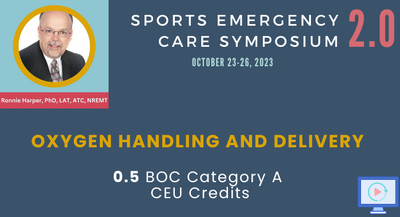Course Info (BOC Domains of Athletic Training; Presentation Description; Learning Objectives; Clinical Practice Gap Statement; Clinical Bottom Line; Summary Conclusions)
BOC Domains of Athletic Training:
- Domain II - Examination, Assessment and Diagnosis
- Domain Ill - Critical Incident Management
-
Domain IV - Therapeutic Interventions
Presentation Description:
This presentation on "Oxygen Handling and Delivery" provides a comprehensive overview of the key aspects of oxygen therapy in clinical settings. It covers the significance of oxygen therapy, the necessary equipment and supplies, preparation of oxygen delivery systems, and various oxygen delivery methods. By the end of this presentation, you will have a solid understanding of oxygen therapy and its practical applications in healthcare.
Learning Objectives:
- Understand the fundamental principles of oxygen therapy and its clinical indications.
- Recognize the critical importance of oxygen in patient care and outcomes.
- Identify the essential equipment and supplies required for safe and effective oxygen therapy.
- Demonstrate the steps involved in preparing and setting up an oxygen delivery system.
- Explore various oxygen delivery methods and their appropriate applications in clinical practice.
Clinical Practice Gap Statement:
While oxygen therapy is a cornerstone in medical treatment, there exists a notable gap in the competency levels of Athletic Trainers in administering and managing it effectively. This gap not only hampers immediate patient care but can also have long-term repercussions on patient outcomes. It is essential to address this shortfall to ensure that Athletic Trainers are equipped with current, evidence-based knowledge and skills for optimal oxygen therapy delivery.
Clinical Bottom Line Statement:
Mastery of the principles and practices of oxygen therapy is non-negotiable for healthcare providers, particularly Athletic Trainers. Understanding the intricacies of oxygen therapy—from equipment to delivery methods—can profoundly influence the trajectory of patient recovery and minimize complications. Being well-versed in this area allows for nuanced care that meets the specific needs of each patient.
Summary Conclusion Statements:
- The importance of oxygen therapy in medical care cannot be overstated, serving as a lifeline in multiple clinical situations.
- Empowering Athletic Trainers with the skillset for proficient oxygen handling can dramatically enhance the quality of patient care.
- Proficiency in the use of oxygen therapy equipment and delivery setups is essential for the success of the intervention.
- Keeping abreast of evolving best practices in oxygen handling and delivery can significantly improve patient outcomes and set a new standard in healthcare delivery.


